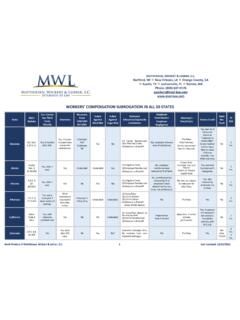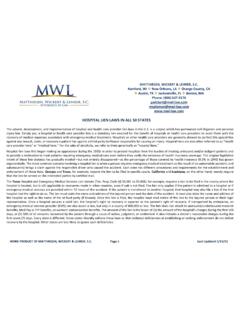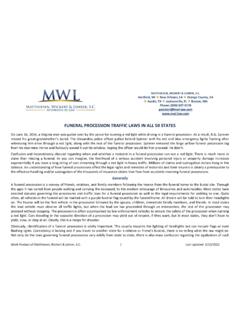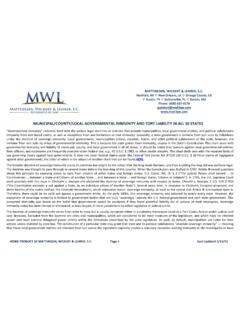Transcription of General Contractor Overhead and Profit Payments Chart
1 MATTHIESEN, WICKERT & LEHRER, Hartford, WI New Orleans, LA Orange County, CA. Austin, TX Jacksonville, FL Boston, MA. Phone: (800) 637-9176. General Contractor Overhead AND Profit Payments IN FIRST-PARTY ACV PROPERTY DAMAGE CLAIMS. Standard homeowner policies pay personal property claims at actual cash value (ACV), which is the replacement cost (RC) of the damaged property based on its current used condition. In other words, it is valued at what it would cost to replace the property at today's cost minus depreciation: Replacement Cost Value (RCV) Depreciation = Actual Cash Value (ACV). The only difference between RC and ACV is a deduction for depreciation. Both are based on the cost today to replace the damaged property with new property.
2 More complicated formulas take the replacement cash value, or RCV, which is the cost to purchase the item new, and multiply it by the depreciation rate, or DPR, as a percentage, and the age of the item. That value is then subtracted from the RCV. For example, a three-year-old dishwasher that costs $500 (ACV) to replace and has a depreciation rate of (DPR), or .125, has an ACV of $ {500-[500(.125)3]= }. States use three types of tests to calculate ACV when a property policy fails to define the term: (1) the fair market value; (2) replacement costs minus depreciation; and (3) the broad evidence rule. 1. Fair Market Value: A price a willing buyer will pay to a willing seller. The term market value in insurance is often synonymous with real value , actual value , and true value.
3 In Jefferson Ins. Co. v. Superior Ct. of Alameda County, 3 398, 90 Cal. Rptr. 608 (1970), for example, it says, It is clear that the legislature did not intend the term actual cash value' in the standard policy form, set forth in 2071 of the Insurance Code, to mean replacement cost less depreciation.. 2. Replacement Cost Minus Depreciation: This is the traditional insurance industry definition. It is the cost to replace with new property of like kind and quality, less depreciation. States differ as to whether or not depreciation includes obsolescence (loss of usefulness as a result of outmoded design, construction). Replacement cost is greater than ACV, and ACV means the full cost of repair or replacement (with deduction for depreciation.)
4 3. Broad Evidence Rule: Used in a few states. It does not blindly follow the traditional measure of ACV (replacement cost less depreciation) and allows for consideration of every standard of value having a bearing on the property under consideration, such as the age of the property, the Profit likely to accrue on the property, and the property's tax value. The majority of states, including New York and New Jersey, follow the broad evidence rule. ACV coverage is popular because full replacement cost coverage premiums can be 15% more than a basic policy. What a policy will pay its insured for property damage also varies depending on whether the damage is to personal property or structural property damage such as a house or building .
5 Claims for damage to personal property are fairly straightforward. For a new refrigerator purchased in 2014 and destroyed in a fire three years later, an ACV policy will generally pay the cost of the television, minus its depreciated value (and any deductible). On the other hand, an RCV policy would reimburse the present-day cost to replace the television, minus any applicable deductible, regardless of its age. Note that accounting or book value has no relevance to either of the previous methods of valuation. The depreciation WORK PRODUCT OF MATTHIESEN, WICKERT & LEHRER, Page 1 Last Updated 1/13/22. rate reflected in book value would yield a terribly inadequate settlement. Another problem with using book value is that it may reflect only the items that are capitalized.
6 Claims for structural damage to homes or other buildings are more complex. If a home is damaged, the owner will receive an insurance claim payment for the cost of the home , minus its depreciated value (and any deductible) under an ACV policy. However, under an RCV policy, the amount of the payment depends on various factors including, but not limited to, whether the structure sustained a total loss or lesser damage such as missing shingles, whether any repairs can be performed, and the specific language of the insurance policy. Determining ACV in first-party homeowner's or commercial property insurance claims can be perplexing and challenging. This is especially true when ACV is not defined in the policy.
7 In most cases, the calculation involves a formula which includes factors such as replacement cost, depreciation, fair market value, and more. ACTUAL CASH VALUE (ACV) POLICIES. Most policies provide Actual Cash Value (ACV) or Replacement Cost (RC) coverage to replace damaged, stole, or destroyed personal property. The latter coverage pays the insured for the actual cost of replacing personal property. For example, the claim payment for a stolen computer would be the cost of purchasing a new computer of like kind. No deduction is considered for wear and tear on the stolen computer. When replacement cost policies and Payments are involved, the payment of General Contractor Overhead and profits (GCOP) is almost always justified.
8 ACV is the depreciated value of property at the time of the loss. It is usually insufficient to replace the damaged item. Rather, it compensates the insured for the value of the item as if it were being sold at a garage sale. The Internal Revenue Service definition is what a willing buyer would be willing to pay a willing seller if neither the buyer nor the seller was under any duress to complete the sale. In other words, what would it sell for at a garage sale. The insurance industry's definition begins with replacement value and then reduces it by some amount for depreciation. ACV policies are subjective. They pay an insured for the fair market value of personal property which is destroyed or stolen.
9 It is also sometimes calculated as the RC. less depreciation. The deduction for depreciation remains the key difference between ACV and RC policies. Carriers that provide replacement cost coverage are usually not going to be responsible for paying more than ACV at the time of the loss unless and until the damaged or destroyed structure is actually repaired or replaced. The term Actual Cash Value is usually not defined in property insurance policies, so three different rules of determining measuring ACV are used: 1. Market Value: This is the difference in the market value of personal property before and after an occurrence. 2. Broad Evidence: Some states give broad latitude to evidence which can be considered to establish the value of the property.
10 Considerations include original cost, market value, income from its use, age and condition, depreciation, and the opinions of qualified expert appraisers. 3. Replacement Cost Less Depreciation: The estimated cost to repair or replace damaged or destroyed property is calculated, and then depreciation is deducted from that amount. Note that depreciation in the insurance vernacular is different than in the accounting world. It is the decrease in the value of property based on its physical condition, age, use, and other factors which affect how useful the property is. Most property carriers provide replacement cost (RC) coverage, but policy language usually does not require an insurance company to pay more than ACV as of the time of the loss unless and until the insured property is actually repaired or replaced.













